IT’S party time on the summit of Mulhacen. Up here in the biting wind, people are laughing and unfurling flags. Dogs bark and food is shared by happy people. Solitary hikers who struggled to raise a grudging “hola” on the long drag up the Loma del Tanto ridge from Hoya del Portillo are suddenly animated and asking strangers to take their picture at the cairn. Mountains do this to people. Especially if the mountain is the highest point in the country.
I once bumped into five Asian lads from Birmingham on the summit of Ben Nevis. They had never climbed a mountain before, and the only reason they were in Scotland was because the wife of one of them had run off with another bloke. So they rallied round their devastated friend and drove him hundreds of miles north for a change of scenery. And there they were on the top of the Ben, whooping and laughing in the snow and the mist, and taking each other’s picture.
And it’s the same in Spain. Here we are at an elevation of 11,423ft (3,482 metres) with cloud and mist streaming past 3,000ft below and an icy cold sky above. Noise; laughter; sandwiches being shared; a babble of different languages; young men unfurling flags of Spain and Catalonia; bearded blokes taking pictures; couples sleeping in sunny hollows out of the wind.


 And all around is this wonderfully surreal, almost lunar landscape of the high Sierra Nevada. Jagged, crumbling arêtes of brown, red and grey rock skirt west to the dark shape of Veleta. To the east lie the rocky summits of the evocatively named Alcazaba (The Citadel) and a host of mountains unknown to me. To the north, the plains and foothills roll to Granada and a haze of blue where land meets sky. To the south is the familiar grey ridge of the Sierra de la Contraviesa with its farms and secluded villages – and Lujar, standing like a full-stop at the end of an adventure story.
And all around is this wonderfully surreal, almost lunar landscape of the high Sierra Nevada. Jagged, crumbling arêtes of brown, red and grey rock skirt west to the dark shape of Veleta. To the east lie the rocky summits of the evocatively named Alcazaba (The Citadel) and a host of mountains unknown to me. To the north, the plains and foothills roll to Granada and a haze of blue where land meets sky. To the south is the familiar grey ridge of the Sierra de la Contraviesa with its farms and secluded villages – and Lujar, standing like a full-stop at the end of an adventure story.
My God, though, it’s cold. It was only 10C when I left the car at Hoya del Portillo before the sun rose this morning. Up here it’s three coats colder. I made good time, though. Four hours and eight minutes from the car park to the summit, pausing only for a quick bite and to pull on some thermal gear at Mirador de Trevelez – where a minibus from Capileira drops those willing to pay for a lift part-way up the mountain on Franco’s dirt road. The minibus is one of the few vehicles allowed beyond the barrier at Hoya del Portillo. And it arrived at Mirador de Trevelez as I rolled up in my dusty boots.
 From just beyond Mirador de Trevelez a track zigzags up the spine of Loma del Tanto to a false summit which tried to catch me out but failed, and on through a rocky wasteland to the unmistakable crown of Spain. And here, on Mulhacen, there is a shrine of ribbons and garlands flying on the wind like a Buddhist temple on a Himalayan peak. There is a ruined shelter that might well have been a chapel, a number of ramshackle stone structures, and lots of happy people mopping sweat from their brows as they throw down their sacks.
From just beyond Mirador de Trevelez a track zigzags up the spine of Loma del Tanto to a false summit which tried to catch me out but failed, and on through a rocky wasteland to the unmistakable crown of Spain. And here, on Mulhacen, there is a shrine of ribbons and garlands flying on the wind like a Buddhist temple on a Himalayan peak. There is a ruined shelter that might well have been a chapel, a number of ramshackle stone structures, and lots of happy people mopping sweat from their brows as they throw down their sacks.
“Señor. You take my picture, por favour? And I take yours, si?”
“Si, amigo.”
Click. Click.
I leave the summit reluctantly and drop down the western screes towards the Laguna de la Caldera, an extremely pretty expanse of turquoise water beneath a fine series of rocky pinnacles.
Here’s some advice for anyone considering ascending Mulhacen by the screes route – don’t. If you’re into masochism, fine, it’s just the job. As a descent it’s fine, if a little hard on the knees. But as a route to the top it’s torture. This is Heartbreak Ridge, Agony Alley, the Path to Purgatory – an unforgiving, totally relentless track that snakes up the scree like a hundred marks of Zorro all linked together in the full glare of the Spanish sun.
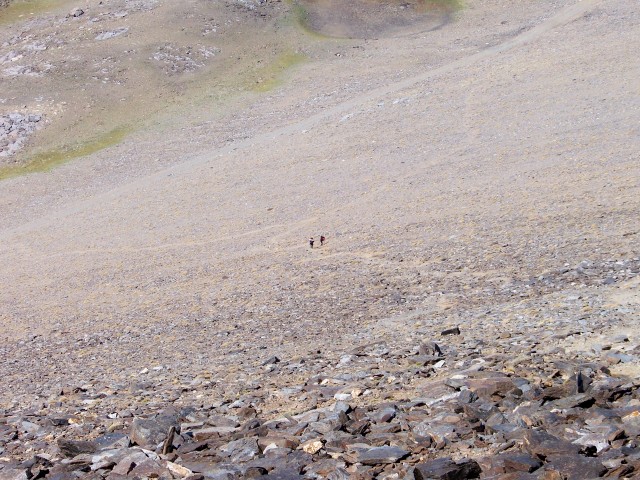 Near the foot of the scree I cross the abandoned trans-Sierra Nevada road that Franco built. Franco didn’t build it himself, of course. He had much more important things to do such as suppress a nation. Apparently he’d moved on from mass killings (but only just) and political cleansing by the time the road was bulldozed during the 1960s.
Near the foot of the scree I cross the abandoned trans-Sierra Nevada road that Franco built. Franco didn’t build it himself, of course. He had much more important things to do such as suppress a nation. Apparently he’d moved on from mass killings (but only just) and political cleansing by the time the road was bulldozed during the 1960s.
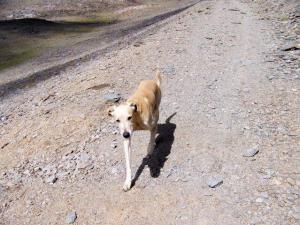 In that great, desolate emptiness I whistle a defiant A las Barricadas and salute the fallen: the valiant men and women of Spain who died in these mountains in the struggle against fascism, and the British, the Irish, the French, Italian, German, American and a dozen other nationalities of the International Brigades and the POUM who fought by their side. And a big dog emerges from the rocks, licks my leg, and disappears again. Big dogs do that all the time in the Sierra Nevada. I don’t know where they come from and I don’t know where they go. Some snarl and bark – some lick your leg. This one is obviously a fellow traveller. No pasaran!
In that great, desolate emptiness I whistle a defiant A las Barricadas and salute the fallen: the valiant men and women of Spain who died in these mountains in the struggle against fascism, and the British, the Irish, the French, Italian, German, American and a dozen other nationalities of the International Brigades and the POUM who fought by their side. And a big dog emerges from the rocks, licks my leg, and disappears again. Big dogs do that all the time in the Sierra Nevada. I don’t know where they come from and I don’t know where they go. Some snarl and bark – some lick your leg. This one is obviously a fellow traveller. No pasaran!

The dog disappears along Franco's road as I drop down to the right and the valley of the Rio Mulhacen, which is nothing but the smallest of streams
 Descending the pleasantly wild stream valley of the Rio Mulhacen, where fresh water ripples delightfully through mossy banks and over ledges, I emerge at the Refugio Poqueira – one of the few refugios that is run on a commercial basis. I’m sure it’s a nice place inside, and I’m certain my first impressions are borne from a reluctance to associate with people who look like they are queuing to get in a nightclub, but I’m struck by the notion it’s a sort of 18 to 30 holiday retreat with mountains thrown in. I’m probably, totally wrong. And if so I apologise profusely to the large group of German girls sunbathing noisily on the terrace and drinking beer.
Descending the pleasantly wild stream valley of the Rio Mulhacen, where fresh water ripples delightfully through mossy banks and over ledges, I emerge at the Refugio Poqueira – one of the few refugios that is run on a commercial basis. I’m sure it’s a nice place inside, and I’m certain my first impressions are borne from a reluctance to associate with people who look like they are queuing to get in a nightclub, but I’m struck by the notion it’s a sort of 18 to 30 holiday retreat with mountains thrown in. I’m probably, totally wrong. And if so I apologise profusely to the large group of German girls sunbathing noisily on the terrace and drinking beer.
Twenty minutes later I pass a block-type shepherd’s building similar to the one I almost strayed inside high on Pico del Tajo de los Machos. The sound of cowbells fills the afternoon air. The scent of pine drifts from the forests below. And way down in the valley I can see dogs shifting an almost fluid flock of sheep to higher pastures.
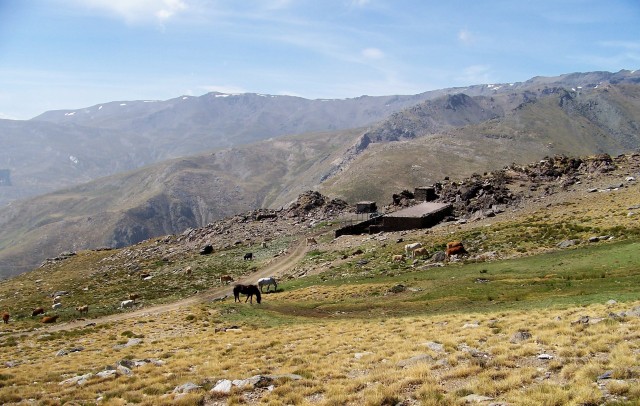 Timelessness. That’s a word that springs to mind when you walk in the Sierra Nevada. Mulhacen is a mountain where the shuttle bus might rattle to the heights of Mirador de Trevelez, and pink young things drink San Miguel on the terrace of the Refugio Poqueira, but high on its flanks shepherds still work in a traditional manner that has survived since the time of the Moors, and possibly the Romans.
Timelessness. That’s a word that springs to mind when you walk in the Sierra Nevada. Mulhacen is a mountain where the shuttle bus might rattle to the heights of Mirador de Trevelez, and pink young things drink San Miguel on the terrace of the Refugio Poqueira, but high on its flanks shepherds still work in a traditional manner that has survived since the time of the Moors, and possibly the Romans.
In this frame of mind I wander the last few miles along lonely tracks to the pine woods above Hoya del Portillo, content in the knowledge I have climbed to the roof of Spain and been – for a few brief seconds – the highest person in this fine and noble land.
Next time I shall take a flag.
- FOR details of Casita La Luz, the perfect base from which to explore the Sierra Nevada and Alpujarras, click here.


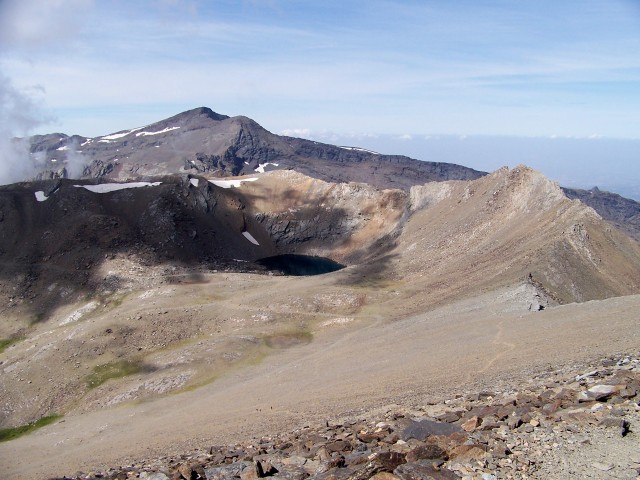
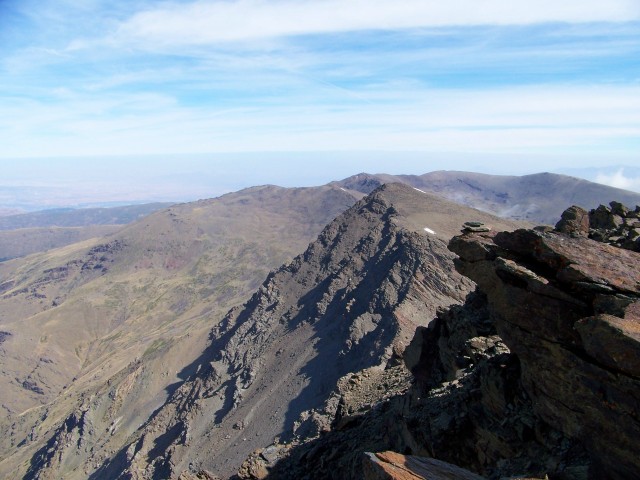

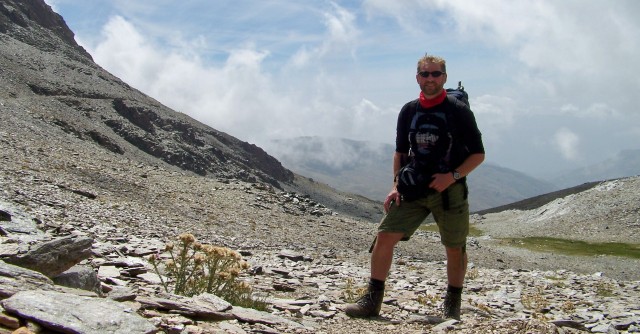










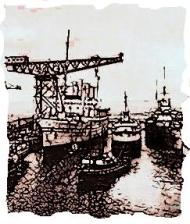
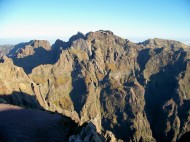
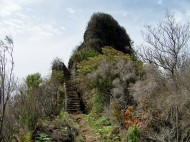
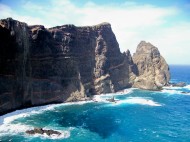




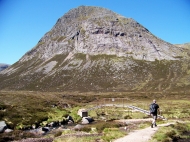


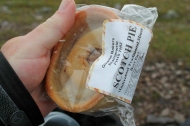
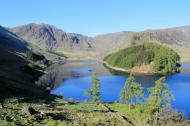


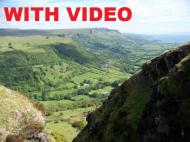
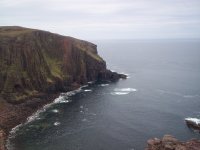
Pingback: maxwellreyes.net
Great pictures – would definitely like to do this one.
Thanks Pete. It’s a great mountain in a great part of Spain.